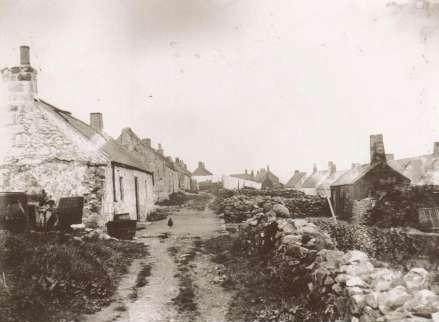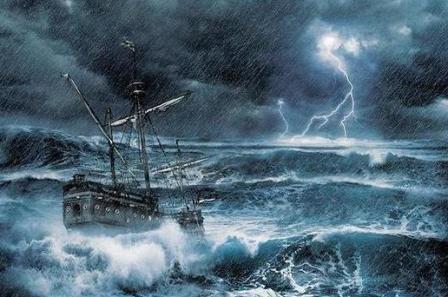
The Mystery of the S.S. England |
Before I start this short story I should add that there have been a few ships that have went by the name S.S. England through history, at least one of which suffered a tragedy when hundreds of crew and passengers died of cholera in 1866 during a voyage from Liverpool to New York.
The particular vessel that we are interested in came from a different time, perhaps around one hundred years earlier than the New York tragedy or maybe even earlier, given that there is no written account of this tale. Our S.S. England also had to contend with tragedy, although of an entirely different nature when it was wrecked on the rocks south of Portlethen Village.
We can only guess at the number of crew and the passengers aboard and we can only guess at the sea state and weather conditions when this ship apparently ran ashore but as you have already seen, if you have read the “Wrecks and Rescues” section of this site, you will be familiar with the extreme weather conditions that frequented our coast and caused tragedy and disaster on a regular basis.
The evening that the S.S. England, which was possibly a large sized brig with a substantial number of crew, ran ashore was one of these dark, stormy winter nights with little visibility. The vessel was running before the wind with no way of knowing that they were so close to land, their first sighting of danger being the increased presence of white water ahead of them. By the time they realised that this signalled danger they were too late to change course or lower the sails, within seconds the white water changed into breakers and dark, ominous shapes hove into view in the restricted light.
Seconds later, the brig crashed down hard on a hidden rock and the vessel hung there before being swept around by a following wave so that she lay broadside on to the weather. The crew, realising their peril, scoured the nearby creek for escape routes, although their vision was hampered with the lack of light and the distraction of the sea spray sweeping over the deck. Realising that there would be no time to lower the small boats some crewmen made the decision to go overboard in an attempt to swim the short distance to sanctuary, knowing that although they weren’t far from safety the chances were that they would be dashed against the rocks or swept in the opposite direction back out to sea.
The
captain and the crew had to make a quick decision on what to do next.
Help was not at hand and no one knew of their peril so it was decided
that it was every man for himself, trust to fate, take to the water and
swim for shore, whether they survived, drowned or were battered against
the rocks was out of their hands. Some took to the water immediately and
disappeared from sight, those still watching from the deck of the ship
not knowing whether their crew mates had sunk to a watery grave or if
they had been lucky in reaching safety.
As the vessel continued to be battered by mountainous seas it began to break up, the aft section starting to part away from the mid section. This was a sign for the remaining men to take their chance and they made their way over the side.
Some men survived but most did not, those survivors that had reached dry land doing all they could to reach and help stricken colleagues still in the water. Soon one or two bodies began to appear in the swirling froth around the rocks and they were pulled ashore to lie on dry land above the shoreline. After around an hour, it was realised that there was unlikely to be any further survivors in the vicinity so it was decided that the handful of men who had managed to escape relatively unscathed should scale the nearby cliffs and braes to try and determine exactly where they were and see if any help was near at hand. These men made their way to the top of the cliffs, leaving behind a few injured survivors who were sufficiently handicapped by their wounds to be unable to leave the spot where they lay. Next to them were around a dozen bodies that had either been washed ashore or had been pulled from the surf by the men who had lived.
On reaching the cliff top the men noticed a faint light towards the north, perhaps little more than a quarter of a mile from where they stood so they headed in that direction, soon discovering that the light was coming from a house within a village, a village that happened to be Portlethen.
The villagers were roused and with the survivors guiding them, beat a hasty path to the scene of the tragedy. On arrival at the scene there wasn’t much to see in the deep gloom of night and it wasn’t until they climbed to the foot of the cliffs that the scene of devastation become clearer; injured men groaning in the darkness, a row of bodies neatly laid out close by and the debris of the shipwreck being washed ashore as far as the eye could see.
The villagers took stock of the scene and, due to the lateness of the hour, it was decided that the injured men, along with those that survived would be taken back to Portlethen to recuperate in the local houses where care and shelter would be provided. At first light they would re-gather and go back to the scene of the wreck to recover the bodies of those left behind overnight.
The next morning, a grim party consisting of a number of villagers and the fittest of the survivors, made their way back to the scene once again and in the cold light of day the aftermath of the tragedy was clear to see, with much of the wreckage strewn northwards along the coast and creating an artificial high water mark.
The men made their way down the braes once again to where the bodies were lying and a further search party was sent out along the coast to check if there were any men that had miraculously survived and may have found shelter in a bay or amongst the rocks, but the search was in vain although a further couple of bodies were discovered and carried back to where the others were lying.
So began the arduous task of recovering the bodies and carrying them up the steep braes before having to fetch them over the fields to a point in the road where they could be collected and taken into Aberdeen where they would have been afforded a proper burial. Despite their valiant rescue attempts and fine hospitality the villagers were determined that the bodies should not be brought back to Portlethen, lest a curse be put on the place. They were God-fearing and superstitious fishermen themselves and they didn’t want the fate of the dead befalling their village.
It was decided that the bodies would be carried to a point midway between the villages of Portlethen and Downies and where there was a coastal track that had easy access for the authorities in Aberdeen to make their way to. After shuttling between the rocks at the foot of the cliff to the road and then back again, all the bodies were eventually laid out alongside the road awaiting transport to cart them off to Aberdeen to their final resting place.
The bodies, which numbered around twelve, were placed at a location just north of where the farm known as “The Wairds” is located today, although back then there was no such farm there. The bodies lay there for most of the day under the watchful eyes of a few village fishermen, who took it in shifts to “stand guard”. As darkness began to fall a procession of four horses harnessed to carts, accompanied by some magistrates of the city of Aberdeen, arrived to collect the bodies and they were hauled away to be buried there the very next day.
Thus was the fate of the S.S. England.
So, is there any truth in this story? Probably not, although there is a slight possibility that elements of this story are true and the vessel that did sink could have been one of the earlier ones that I have listed in the wrecks and rescues section.
When we were young we had heard stories about a large shipwreck that had happened in the area “many years ago” where the bodies were carried up from the edge of the sea to a place at the edge of the coastal road and were laid out for a day there ready to be collected.
As kids, we embellished this story, always adding an extra gory detail here and there in the retelling. In fact with each retelling of the story, the tale continued to grow arms and legs and with the artistic license I’ve taken with my version here it’s grown so many appendages that it probably resembles a bag full of octopi!
There are a few coincidences. Why is the nearest building to the alleged site of the tragedy called England Farm? Could it have been named after the ship that went down in that locale? Why are there a range of rocks and a small craggy bay in this vicinity called “The Englishman’s Neuks?” Could this in any way be related to the fate of the S.S. England?